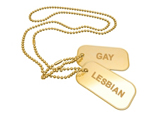Gays in the Military

Homosexuality has been an issue for America’s armed forces since the nation’s founding. [1] In 1778, George Washington approved the dismissal of a lieutenant from the Continental Army for “attempting to commit sodomy” and allegedly lying about it. [2] Despite such measures, homosexuals continued to serve in the nation’s military. Periodically, the military stepped up its efforts to drive them out. In 1919, for instance, a young Franklin D. Roosevelt—then-assistant secretary of the Navy—oversaw a large sting operation to entrap and expel gay soldiers. [3] During World War II, the armed forces introduced psychological screening of recruits and banned anyone deemed to have “homosexual proclivities.” [4] After the war, President Harry Truman ended racial segregation in the military in 1948; yet he and his successor, Dwight D. Eisenhower, simultaneously toughened restrictions on gays in the military. Service members who admitted to being gay or who were convicted of homosexual behavior were dishonorably discharged and stripped of their pensions. By some estimates, discharges during the Cold War increased tenfold.
In the early 1980s, the Pentagon responded to growing challenges—both popular and legal—to its policy by spelling out exactly what it forbid. In 1982, the Department of Defense (DOD) issued a ruling which was added to the Uniform Code of Military Justice. The verdict was unequivocal: “Homosexuality,” the first sentence read, “is incompatible with military service.” The report said that the presence of gays “seriously impairs the accomplishment of the military mission.” It was their very presence, not their behavior, which was at issue: “The presence of such members adversely affects the ability of the Military Services to maintain discipline, good order, and morale.”
The new rule meant that a service member could be discharged and denied his or her pension for meeting any one of the so‐called SAM conditions: statement of orientation, act or attempt to marry. With the more stringent restrictions in place, the military discharged 2,000 service members in 1982 alone—the most it had ever expelled in a single year. Over the next decade, the DOD dishonorably discharged 17,000 service members for various SAM violations.
Don’t Ask, Don’t Tell. One of President Bill Clinton’s first acts upon taking office in January 1993 was to fulfill a campaign promise: repeal the ban on gays in the military. Clinton’s executive order lifting the ban, however, unleashed a new storm of controversy and the President was forced to compromise. The result was a new policy, known as “Don’t Ask, Don’t Tell, Don’t Pursue,” announced in July 1993. It reinstituted the ban on openly gay service members, but barred pre‐enlistment questions about sexual orientation. Officers would no longer ask about their subordinates’ orientation and, as long as service members didn’t tell superiors they were gay, and didn’t engage in homosexual acts while on active duty, they were free to serve.
“Don’t ask, don’t tell” had critics on both the right and left. Conservatives felt Clinton had gone too far, undermining military morale and discipline; liberals felt his order fell short of real reform, and they continued to lobby for full repeal. In practice, the new policy seemed to have little effect, with minimal drop‐off in expulsion rates. From 1993-2008, 12,000 people were expelled from the armed forces because of their sexual orientation. (Most of the dismissals happened before 2001. After that year’s terrorist attacks and the start of wars in Iraq and Afghanistan, dishonorable discharge numbers dropped sharply.) [5]
[1] Randy Shilts, Conduct Unbecoming: Gays and Lesbians in the U.S. Military (New York: World Publication), 1997, p.11.
[2] The lieutenant, Frederick Enslin, was “drummed out of camp.” George Washington, The Writings of George Washington from the Original Manuscript Sources: Vol. 11 , Electronic Text Center, University of Virginia Library, http://etext.virginia.edu/etcbin/toccer-new2?id=WasFi11.xml&images=images/modeng&data=/texts/english/modeng/ parsed&tag=public∂=all , p.5-24, Accessed November 2, 2008.
[3] The resulting public outrage centered not on the Navy’s tactics, but on the explicit testimony of the sailors caught in the investigation. Many newspapers refused to disclose the details, calling them “unprintable.” John Loughery, The Other Side of Silence: Men’s Lives and Gay Identities, A Twentieth-Century History , Excerpted in the New York Times , September 20, 1998.
[4] Amy Lind and Stephanie Brzuzy, Battleground: Women, Gender, and Sexuality (Westport, CT: Greenwood Publishing Group), 2008, p.300-301.
[5] Mark Thompson, “‘Don’t Ask, Don’t Tell’ Turns 15,” Time Magazine , January 28, 2008.